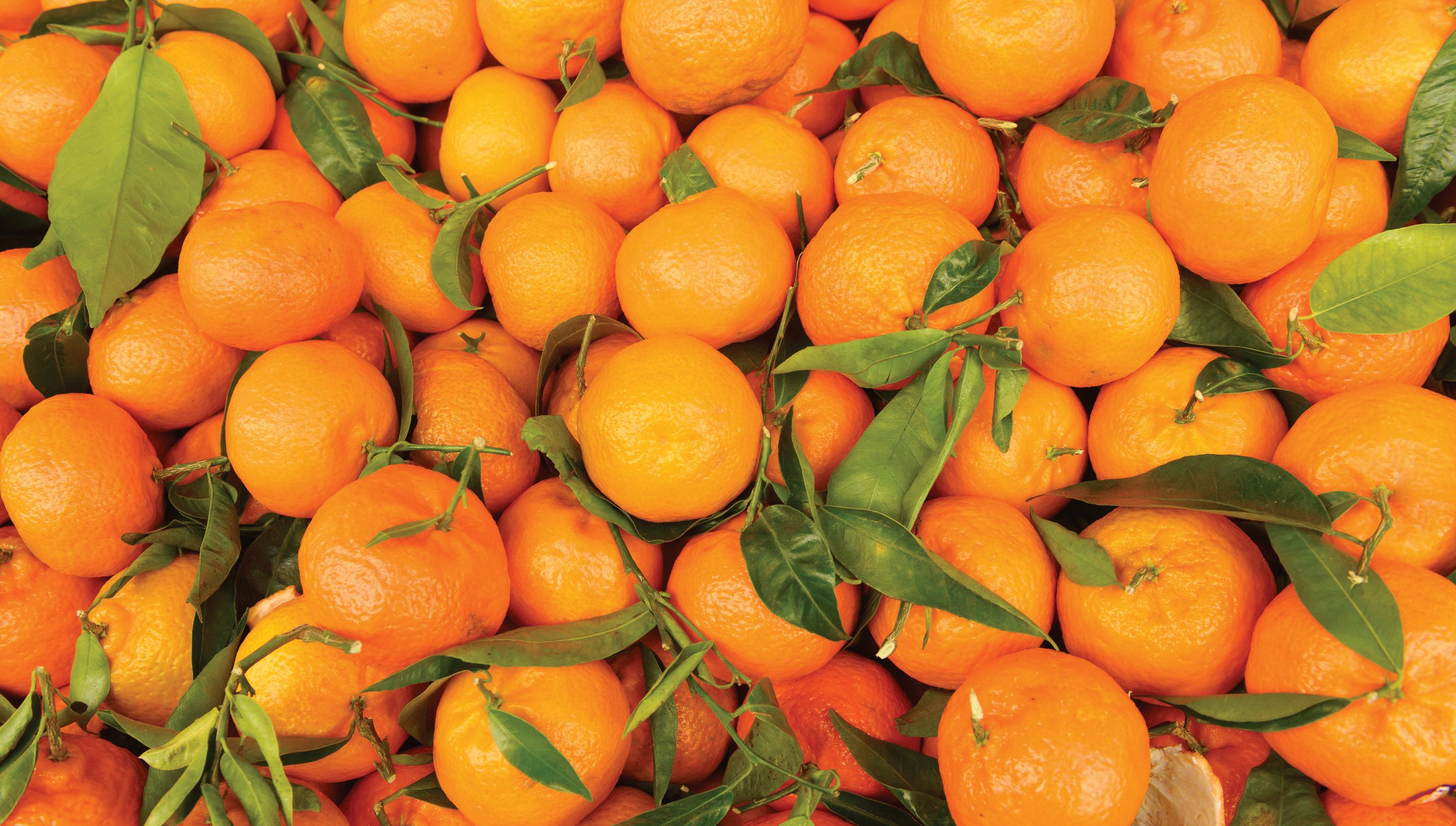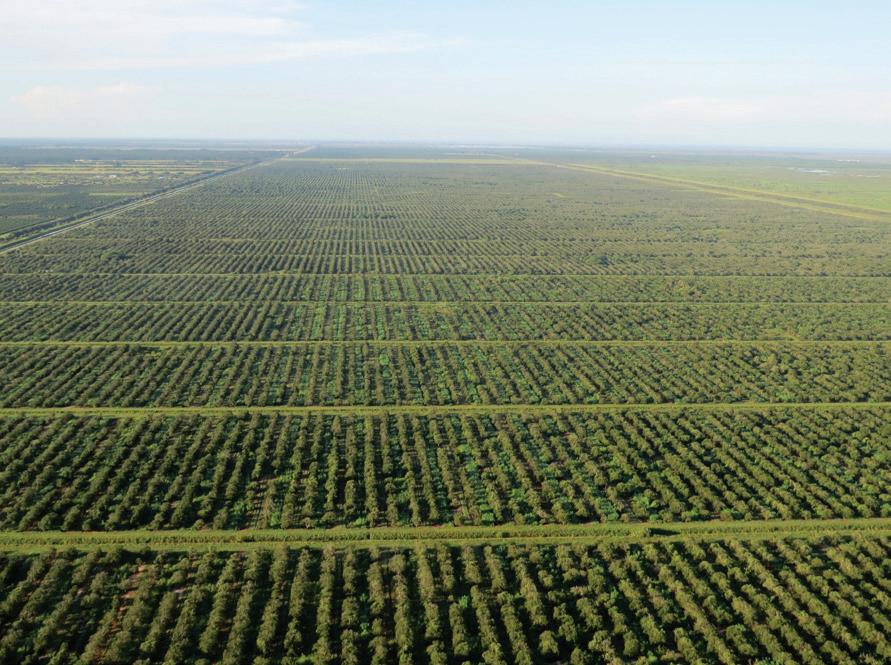
7 minute read
ANNUAL CITRUS REPORT
Growers Faced Familiar Challenges, But Late Rally Holds Hope for the Future
by TIM CRAIG
Advertisement
JULY MARKS THE END OF THE 2020-2021 Florida citrus season, and for some growers, it’s been a season of both surprises and challenges. While there was a possible ray of positive news late in the season, there are longterm issues the industry continues to battle.
As the season got underway, the USDA’s official October forecast predicted 57 million cases from Florida groves — a somewhat significant 15 percent drop from 2019-2020 final output of 67.3 million. The numbers continued to slide through the season, according to the monthly USDA forecast updates. In December, the forecast dropped to 56 million. In January it dropped to 54 million. By April and May, the forecast had dropped to 51.7 million.
June’s forecast update saw a slight late-season rally, up to 52.7 million boxes — 30 million for Valencia and 22.7 million boxes for non-Valencia oranges. The final forecast is scheduled to be published in mid- to late July. Final totals will be published later this year.
For growers, the season provided new challenges but also new points of hope.
“It was kind of a confusing season — we met our expected yield count, but the fruit quality levels were way down and we had trouble meeting the minimum brix levels pretty much all season,” said Charles Counter of Counter Ag Services in Haines City. “That was the biggest thing; but overall, the fruit prices were good and yield was OK.”
Counter said that part of the confusion through the year included what he described as a “beautiful, uniform bloom” that he had not seen in the past several years and which gave him hope for a higher-than-expected crop. However, after the bloom, the effects of the drought hit the trees hard.
The lack of rain and the long-term effects of greening took a toll on the trees, particularly the older ones. Counter said he saw a lot of dropped leaves and fallen branches. He started a regimen of spray fertilizers to feed the root system and to try to build the trees back up and get the crop back on track. The extra efforts paid off, particularly in the younger trees.
For Rob Petteway of Petteway Citrus and Cattle in Zolfo Springs, the bloom was a good sign; but that was before the effects of the drought.
“When that bloom happened, I thought, ‘This is going to be great,’ but by May 1, the groves looked terrible, with dead limbs, especially on the trees that were 20-plus years old,” says Petteway. “But now when I go out to the groves, I see that things are looking stronger. Since we’ve been getting rain, things are coming back pretty decent. You know, orange trees are pretty resilient.”
— CHARLES COUNTER OF COUNTER AG SERVICES IN HAINES CITY
The dry weather caused other surprises, including a delay in picking some of the Valencia oranges, according to Petteway. “They kept waiting to get the brix ratios to where they wanted them,” he says. “It was a nightmare to get the fruit picked.”
Petteway also said that the production side faced setbacks at overwhelmed processing plants.
The challenges growers faced this season exist under the looming, continual threat of greening that has plagued the industry for over 15 years. For Ray Royce, the Executive Director for the Highlands County Citrus Growers Association, and the growers he sees during the season, these issues are intertwined.
“Obviously the rains late in the season helped out a lot, but looking back, my biggest concern is that we cannot continue to withstand a 30-50 percent drop rate,” he says. “We’ve learned to keep a tree viable, how to have a good bloom and for the tree to function, but the question now is how do we get a higher percentage in the truck?”
Royce said he sees trees three to four months out from harvest that look healthy, but when he sees the color of the stems, he knows that the fruit will eventually shake loose before harvest. He also said that he’s not hearing growers share success stories about things they can try that work to combat these issues.
“It’s going to come down to growers sharing information with each other and we need the research community to make a short-term priority on how to get higher quality at the end of the season,” he says. “I say ‘short-term’ because we don’t have time for a multi-year study and published research, we need people’s best-educated ideas and take those ideas out of the small, research groves and get those trees out into a real-world situation. Long-term, we need an answer as to how we breed ourselves out of this situation. How do we breed resistant or tolerant trees for the next generation?”
Despite it all, though, both Counter and Petteway took the ups and downs of this season in stride and remain committed to and positive about Florida’s citrus future.
“I think that because of the uniform bloom and the late rally, we could see a more uniform size of the fruit and the maturation could be more consistent next season,” says Counter. “Every season seems to be different because of the effect of the greening, but the groves are still alive and a lot of people didn’t think that would be possible when we first started seeing (greening) 15 years ago.”
For Petteway, part of his optimism for the future can be seen in his certified greenhouse citrus nursery that operates as part of Petteway Citrus and Cattle and produces over 50,000 trees per year.
“We keep selling citrus trees, so I don’t think (the industry) is going anywhere,” he says. “Every year has its problems and every year has its bright spots, but we will always remain very bullish on citrus.” ag

JULY SUMMERTIME GARDENING KNOW-HOW
IT’S JULY, and the Florida summer is upon us, which means it’s time to arm yourself with the knowledge that will keep your lawn and garden looking victorious for the remainder of the summer. Now is the time for summer fertilization of your lawn. Repairing, renovating and planting are also good ideas. Before planting, don’t forget to work organic materials, such as peat, manure and compost, into your soil.
For this month, spraying your roses weekly with a good fungicide such as Thiomyl, Daconil, Dithane or M-45 is key to the plant’s health. Rose bushes are especially hungry plants, so feed them on a regular basis.
Remember, weeds grow at a lower fertility level than turf grasses. Weeds thrive when a lawn is hungry. Feeding and mowing your lawn on a regular schedule will result in vast improvements. Since fungus diseases thrive in July, watch your grass and use a good granular turf fungicide if you see disease rear its ugly head.
Spider mites attack most plants and can do serious damage. Fight back using a miticide, such as Merit—a tactic that is tried and true against these problematic pests.
Make sure you watch for scale insects, as well. Whiteflies, chinch bugs, sob web and armyworms are some of the more common nuisances. We have exactly what you need for these battles and the know-how to guide you, so you can ultimately win the war and free your lawn and garden of these pests.
by WILLIAM "BILL" DOTY This column is sponsored by Doty Farm and Garden Supply, Inc., and the opinions expressed herein may not reflect those of CFAN or of its advertisers.
BIO: William R. “Bill” Doty is the owner of Doty’s Farm and Garden Supply Inc. Founded in 1954, Doty Farm and Garden Supply, Inc. has been there for every one of their loyal customer’s budding needs. Bill Graduated from Winter Haven H.S. and then Florida State University, where he learned invaluable lessons in listening, asking questions, and reading anything related to the family business. Bill shares his knowledge with his customers daily and our readers each month.


